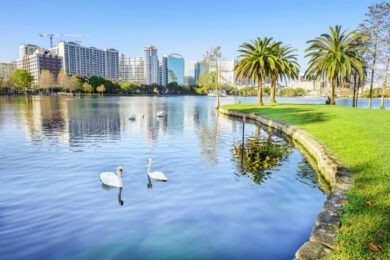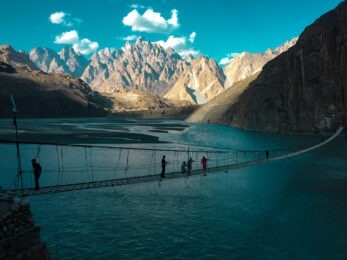Today’s aloha spirit is all about sustainability
77
degrees average year-round
50,000
hotel rooms
11 million
air seats from U.S. mainland and Asia-Pacific per year
200+
interisland flights a day
1,052
miles of coastline
8.3 million
visitors per year
500,000
visitors for meetings, conventions and incentives last year
1.4 million
residents
136
zip codes
1
area code
The first Hawaiians arrived some 1,600 years ago, by canoe. This year, in a similar Polynesian canoe named Hokulea, Hawaiians completed a round-the-world journey across 40,000 nautical miles of ocean using the same navigational aids as the original voyagers—the sun, stars and ocean swells.
Malama honua, the rallying cry for this epic voyage, means “to care for our island Earth.” But as the Hokulea website notes, “The Hawaiian language is beautiful and complex. Malama honua [also] means to take care of and protect everything that makes up our world: land, oceans, living beings, our cultures and our communities. It means learning from the lessons of islanders to take care of your limited resources, as though you were living on a canoe in the open ocean or an island in the middle of the sea.”
Sustainability is a clarion call to action in our 50th state. And with good reason. As the most isolated archipelago on Earth, it is buffered from many of the world’s woes, but in its very apartness lies a threat that only sustainability can begin to address.
This year, Gov. David Y. Ige pledged to double agricultural production by 2020. He also put the state’s power grid on a path to be 100 percent renewable by 2045. Because climate change is causing rising sea temperatures around the world, Hawaii suffered its first statewide bleaching of coral reefs in 2015. Ige is working to reduce stressors on reefs, including illegal and unsustainable fishing. Also targeted are threats to rainforests and endangered species (Hawaii has more endemic and endangered species than any other state), especially from invasive species.
Hawaii is still a heavenly paradise. As visitors to the Aloha State, we can witness for ourselves the grandeur and kaleidoscopic variety in these and many other ways:
- Team-building on a Super SUP (14-foot-long stand-up paddleboard) on which up to six people can explore the near-shore marine environment off Puu Kekaa (Black Rock), with Hale Huakai in Kaanapali, Maui
- “Greening your seat” on Paradise Helicopters tours of Oahu, Lanai and the Island of Hawaii by the planting of an endemic koa tree on the Island of Hawaii
- Flying from Hawaii’s only plank-launch zipline, thrill to 200-foot drop-offs and reach speeds faster than 50 mph, on Kauai, with Hawaii Ecotourism-certified Skyline Eco-Adventures, which has donated more than $1 million to nonprofit groups since 2002
- “Talking story” with farmers and makers of artisanal products about how they farm or craft their products, and the best ways to use them, followed by a lunch showcasing a featured farmer or product at The Red Barn Farmstand, at Haleiwa, on the idyllic North Shore of Oahu
So, slip a fragrant melia (plumeria) flower lei over your neck, and join our tour for meeting professionals of the best, latest and most sustainable on these storied islands—and in malama i ka hanauna (preserving it for future generations).
? Hawaii Insider Tip
Locals mix Hawaiian words into everyday exchanges as a sign of cultural respect. You no doubt already know several words in Hawaiian, the 13-letter language that enjoys official status with English (and not to be confused with Pidgin, a hybrid vocabulary created so Japanese, Chinese, Portuguese and Filipino immigrants, as well as native Hawaiians and Americans, could do business). Popular words include: aloha (hello, goodbye, love), mahalo (thank you) and lei (floral garland given as a greeting or for an occasion).
Other handy words to know:
- Hale (house or building)
- Kama aina (local resident)
- Kane (man)
- Keiki (child)
- Makai (toward the sea)
- Mauka (toward the mountain)
- Ohana (family)
- Pau (finished)
- Wahine (woman)
? Hawaii Insider Tip
Edible Hawaiian Islands is your go-to. When it comes to the latest in organic and sustainable dining, farmers markets and food events throughout the state, consult this quarterly print magazine whose issues are also available online. It also has tons of fun information about Hawaii’s food culture, farms and ranches.
Talking Story with Mary Neister

To talk story is an everyday Hawaiian expression that means “to chat informally” or “to shoot the breeze.” Linguistic scholars trace its origins to ancient Hawaii, where in the absence of a written language an oral tradition evolved of sharing history, mythology, genealogy and how-to stories. We talked story with Mary Neister, vice president of Meet Hawaii.
What valuable lessons about sustainability can visiting groups learn from Hawaii and its vibrant culture?
Whether touring the farm at Waipa Foundation on Kauai to understand the importance of Hawaii’s canoe plants, enjoying a farm-to-table dinner at Humuhumunukunukuapuaa on Maui that offers a guided tour where participants learn to forage for food based on the Hawaiian moon calendar, or visiting Heeia Fishpond on Oahu—an ancient Hawaiian resource that engages visitors in its history and restoration efforts—the Hawaiian Islands provide unique and tangible ways for groups to interact with the Hawaiian culture and understand the values that have shaped how Hawaii’s people live, and the inspiration for aloha spirit.
What can meeting and event professionals do to support sustainability while in Hawaii?
In addition to participating in various activities that promote sustainability, the Hawaii Convention Center, the state’s largest meeting space, recently announced a partnership with the Hawaiian Legacy Reforestation Initiative to plant 1 million legacy trees throughout the state, in addition to providing educational and sponsorship opportunities. Groups attending a meeting at the Hawaii Convention Center are encouraged to inquire about ways to engage in this partnership.
From a sustainability perspective, why is this the right time to book events and meetings in Hawaii?
Sustainability has always been, and will continue to be, an important focus for the people of Hawaii. There is a sincere commitment to leave these islands a better place for the benefit of future generations. This includes efforts by Hawaii tourism industry partners to do what they can to be greener and more sustainable in providing groups with the best meeting experience.
Then you have Hawaii’s natural environment, a quality unmatched by any other meeting destination in the world. Year-round warm weather, spectacular vistas and fresh air inspire attendees to be relaxed, focused and enthusiastic about the business at hand, and be more productive at work. Hawaii’s diverse landscapes, unique history and rich cultural heritage create a variety of nontraditional meeting venues and group activities that stimulate different perspectives and closer connections among team members.
How does a meeting professional decide which island is best to sustain her or his next meeting or event?
The Meet Hawaii team of experienced professionals is an invaluable resource for meeting planners, particularly at ensuring that a group’s meeting, convention or incentive program delivers on the desired outcomes by corresponding their program needs, activities and services with the ideal setting statewide. The Hawaiian Islands offer a seemingly endless number of pre- and post-meeting activities for groups to enjoy. With six islands, each one featuring unique experiences, attendees have a great opportunity to arrive early or extend their stay to take advantage of all the activities and attractions Hawaii offers. To gain a better understanding of what the Hawaiian Islands can provide, planners are encouraged to visit Meet Hawaii.




